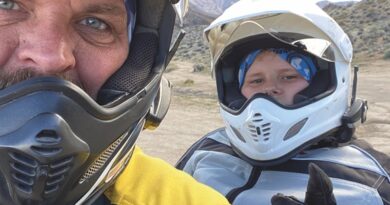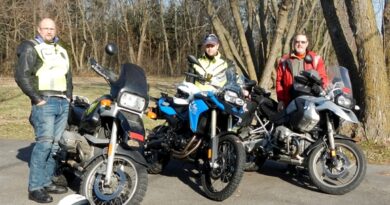A rite of passage (Part 2)
On a road trip lasting four months and more than 24,000 km (15,000 miles) it can be difficult to really get to know the places one visits. When you are on the tourist trail of top-rated site after site, are you really spending time getting to know the real people and their culture? Yes, Janel and I only spent our trip in Canada; however, Canada is a mosaic of different cultures, traditions and languages that are dispersed across its vast landscape. Finding a place that demonstrates the history and a true story of its people is priceless to me. After taking on what would be the most difficult section of our cross Canada trip, we stumbled upon a place that not only gave us some rest and relaxation, it also taught us the unique and special history of the people who inhabit Labrador. We still, however, had to get there.
With Route 389 behind us and 533 km (330 miles) of the Labrador Highway completed, our spirits were riding high. We spent two nights at the Royal Inn and Suites in Happy Valley-Goose Bay hoping to explore the area and learn about the region. Other than a beautiful hike on the Birch Island Boardwalk, however, the rain (once again) kept us rather sheltered in our hotel. I spent the time instead preparing our bikes for the 404 km (251 miles) stretch of highway that connected Happy Valley, Goose Bay and Port Hope Simpson. This barren stretch of highway is well known for its lack of facilities; for this length of the journey there are no towns, no gas stations, no rest stops, no cell service; just trees, muskeg (swamp), and likely moose. Traffic as well is limited on this road; thus, a breakdown is not recommended. With this in mind, I set to checking our chains, tire pressure and oil, and gave the bikes a bit of a cleaning under the hotel overhang. With the bikes in peak condition, the next day we filled up our jerry cans with premium fuel and started what I was confident would be the last real challenging part of our journey.
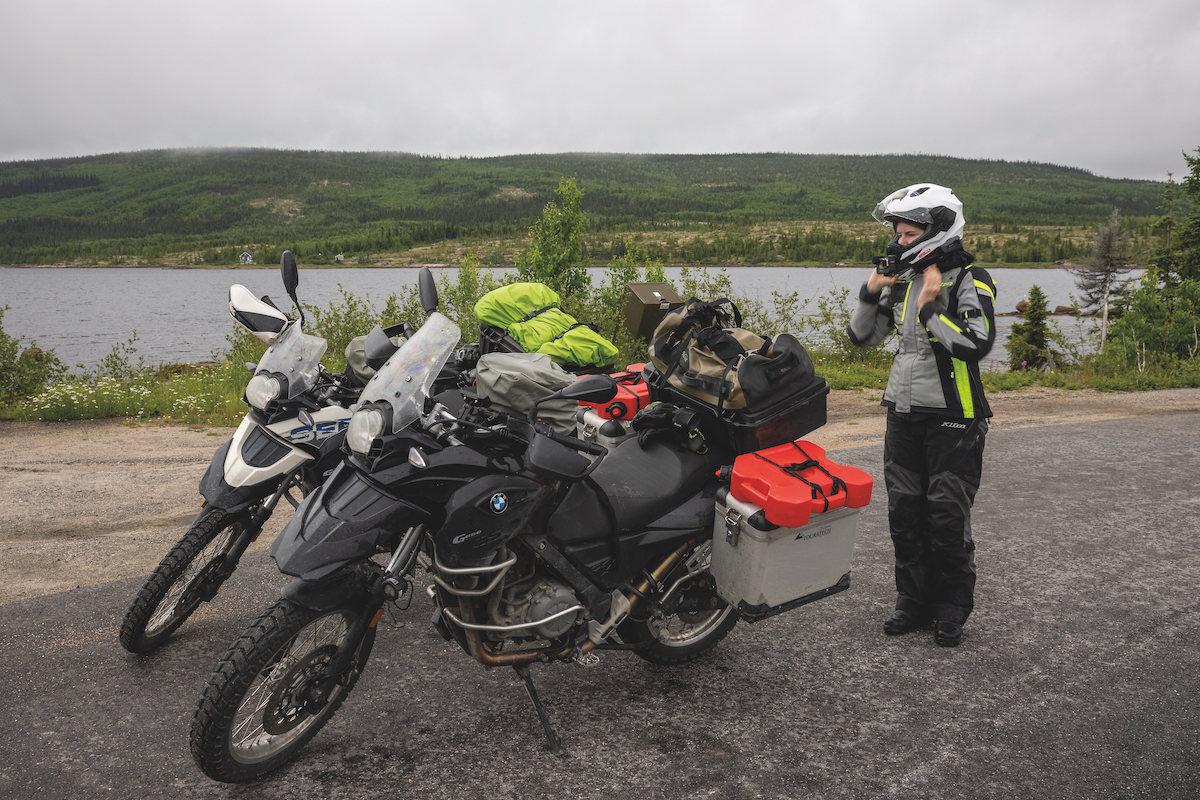
The weather forecast for the day was cloudy and around 14 degrees Celsius (57 Fahrenheit), which for July was a little on the colder side. We bundled up (something we were very accustomed to at this point) and hoped the clouds would hold the rain back. Our first challenge came quickly; to leave Happy Valley-Goose Bay we had to cross over the Churchill River via the 360-metre grated bridge. For those of you who have not ridden over a grated bridge, it really isn’t a pleasant experience as the bike doesn’t feel stable and the tires slide around a bit. On this day, the bridge was also damp from the previous day’s rain, which just added insult to injury. So far on this trip I had been the calm team member when things got difficult, but not on this day. With each swerve of the bike my butt checks clenched hard enough to break steel, my knees squeezed the bike as I kept repeating the mantra “look where you want to go,” and I tried to keep my hands loose on the handle bars. After what felt like hours, my front tire came off the bridge onto the flat asphalt, and the tenseness in my body was finally released when I saw Janel make it across the bridge safely in my rear-view mirror. With a laugh and a sigh, we both hoped this was not a sign of things to come.
Leaving civilization behind us, we journeyed into the vast wilderness that is Labrador. The muskeg hugged the road tightly, and as we came up over hills, we could see the empty road stretching for miles out in front of us. We had made a plan that we would stop every 100 km (62 miles) to stretch and rest our bodies to prevent us from getting too tired. The engineers in Labrador planned well; there were several pullouts for us to stop at to take breaks, have a walk and enjoy a snack. At our second stop, I was pulling out some cookies we bought in Happy Valley-Goose Bay, and as I turned around, I noticed Janel was pulling off some dance moves next to her bike.
“You are in a good mood,” I said while observing this beautiful woman break down some pretty awesome moves in her Sidi Adventure boots.
“I am freezing!” Janel replied, as she continued to bust a move. “I have to warm up somehow!” I went back to the bike and grabbed her some hot water. After a few sips the dance party ended.
“We are halfway and at least it isn’t raining,” I told her. So far, the clouds had held, and I could only hope they would continue to hold for a few more hours.
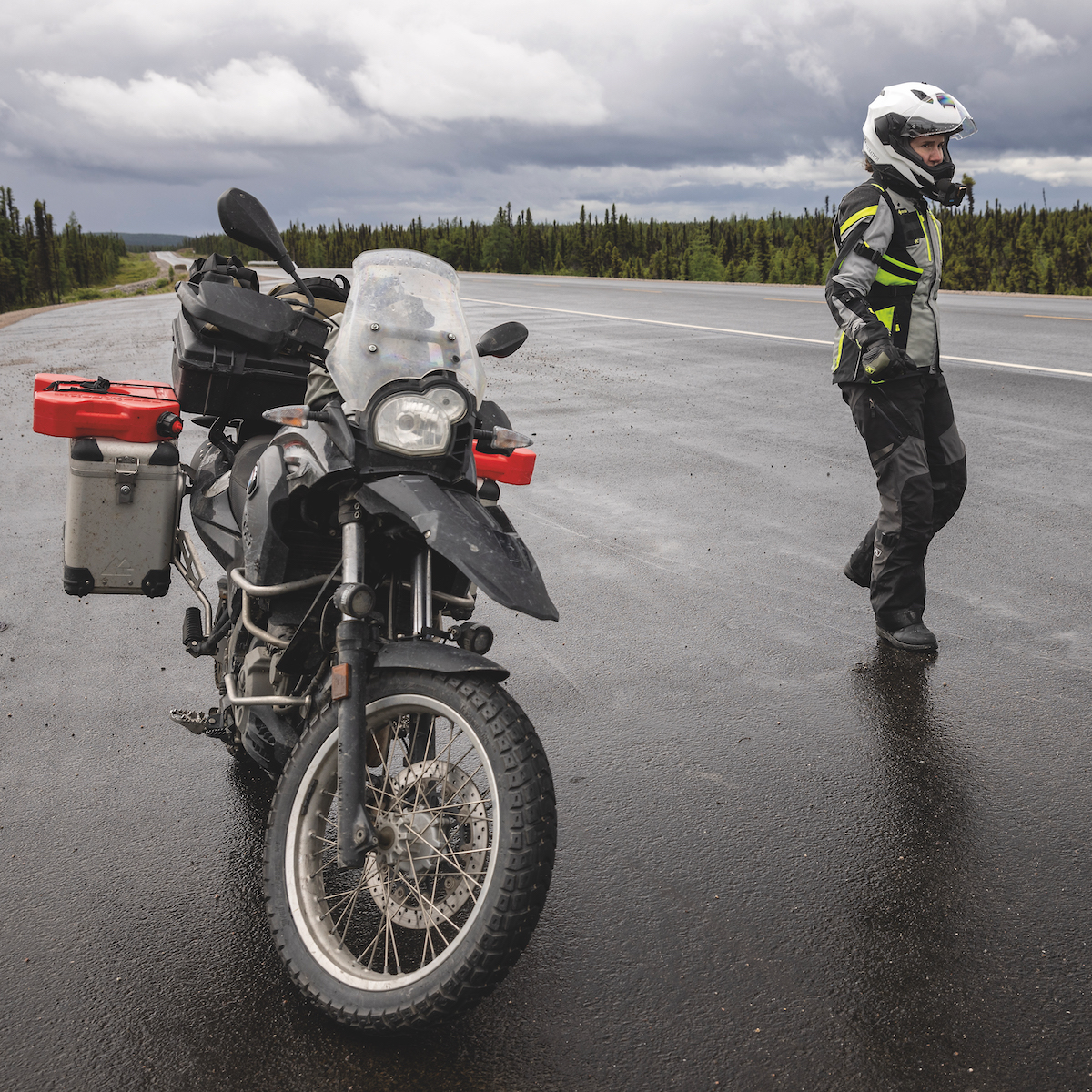
When we hit the 300 km (186 mile) mark, we crossed a bridge and found a little rest stop next to a river. It was a lovely spot, and we thought it would be a perfect place to refuel the bikes. Taking off our helmets, we noticed an information sign and were able to see how far we had come. Actually seeing on the map the distance we had already travelled reinvigorated our stamina. We were already feeling the rush of accomplishment. This wonderful feeling was dampened at this exact moment as blackflies discovered our presence. The swarm attacked us from all angles, they ravaged my face as I tried to fuel the bikes. Janel continued to dance to not only warm up, but to keep the little menaces off her. With only a little fuel wasted as I swatted the flies away, we had full tanks and tore out of our makeshift fuel station much quicker than when we arrived. (Note for anyone hoping to do this trip, don’t stop near a river to refuel.)
The rest of the ride was uneventful. For the length of the barren road the rain never came. We passed 17 oncoming vehicles (three of which were motorcycles) and did not have a single issue with our bikes. We searched Port Hope Simpson for Campbell’s Place Inn where we would rest our heads that night, while our stomachs rumbled with the thought of a hot meal. Once we arrived, I started unloading the bikes and that was when the clouds broke open and rained poured down from the heavens. Getting everything inside as quickly as possible, I was pleasantly surprised by the washer and dryer in the common room. Being able to do laundry for free on a four-month road trip is always a blessing. After a hamburger and some fries at the hotel restaurant, we did some laundry and fell asleep listening to the rain drops outside.
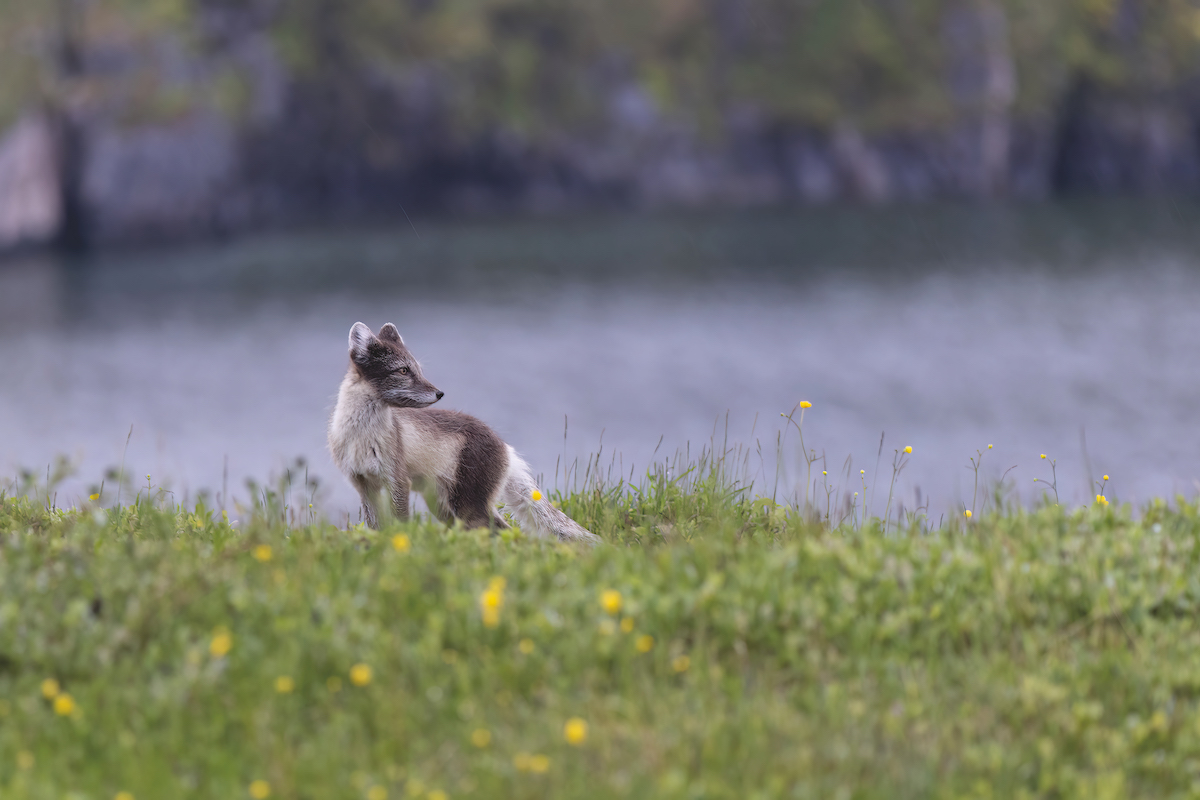
The next morning, we were in for a short 50 km (30 mile) ride to Mary’s Harbour where we would take a ferry to the remote fishing community of Battle Harbour. It was an uneventful, short ride. We turned off the Labrador Highway towards Mary’s Harbour and to my excitement we hit a rough and potholed dirt road. The heavy rains of the year had done some real damage to some of the dirt roads that branched off from the Labrador Highway, and this gave us another opportunity to put our skills and Motoz tires to the test. Janel followed my lines as we switched from one side of the road to the other trying to avoid getting into ruts for the one-kilometre ride into town. Arriving in town, we had a bit of extra time before our sailing, so we headed to the Great Caribou Studio and Café. Charlene Rumbolt was there to greet us with smiles, coffee and stories of the area. One of the most interesting stories was the fact that Great Caribou Island, which is located just across a small section of ocean from Battle Harbour called a “tickle.” has caribou on it for the first time in many decades. The caribou have been declining for many years in Labrador due to climate change and over hunting, and their resurgence was seen as a sign of positive change. After some more coffee and stories, we rode the bikes to the harbour to catch our ferry to Battle Harbour.
Not being near the bikes for three days was going to be strange: as we left them in the parking lot, I felt as though I left my dog sitting on the side of the dock. I could almost hear the bikes revving in sad melancholy tones, missing us as much as I missed them. With reassurances from the staff that the bikes left there would be well looked after while they awaited their owners’ return, I turned my focus instead to our ferry ride into the Atlantic Ocean.
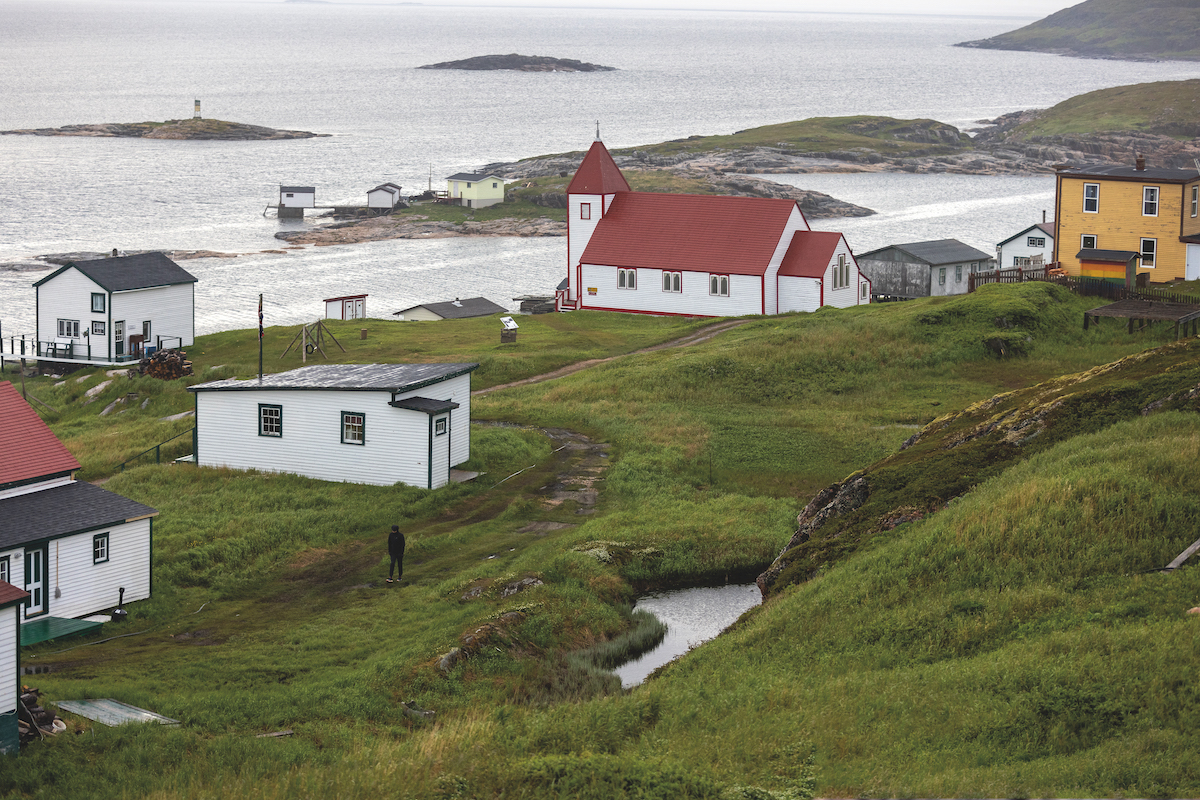
Sailing to Battle Harbour, the clouds were low in the sky and the wind was picking up making the boat sway and crash among the waves. Nelson, a long-term resident of Battle Harbour and Peter, the Executive Director, showed us a map of the area and gave us a short summary of what to expect when we arrived. Nelson had a thick east coast accent that could be difficult to follow if you didn’t listen carefully along with a dry sense of humor that you really had to watch in order to avoid getting caught being gullible. The stories made the sailing go by quickly and as we came into the tickle that separates Battle Harbour from Great Caribou Island, Janel and I were both shocked at the beauty of the place. The rocky island devoid of any trees or vegetation higher than a person’s waist was dotted with several old east coast fishing homes built on stilts climbing from the ocean up to a rocky cliff; fog and mist drifted between the homes, while a small amount of rain added a slight chill to the air. In the middle of all the homes sat a red and white church, and further down the island near the narrowest point of the tickle was the dock and some staff patiently awaiting our ferry.
After a quick orientation of the area, a staff member walked us the short way to the traditional fishing home where we would be staying. Entering the house, we were welcomed by a modern meets classical home design: a wood stove was burning in the dining room/kitchen which instantly took away the chill from the boat ride; beautiful photographs of the area adorned the walls; upstairs we had a plush queen bed with a small window that looked out onto the ocean, and in another room two twin beds (I think Peter might have been concerned we had spent too much time together). More than pleased with our accommodations and with camera in hand, we followed the many boardwalks to the dining house for our first meal on the island.
As there are no shops on the island, and all meals are prepared for guests. Cooking up traditional Labrador meals, the cooks dedicate time to ensure each meal is one to be remembered. One of our favorite items were the traditional biscuits. When I mentioned this to Daphne, one of the cooks and another long-term resident, she invited Janel to come and make some biscuits with her. With apron on, Janel dug her hands into the dough, getting a solid arm workout, while Daphne told us stories of growing up on the island with her more than ten siblings. This was one of the most interesting parts of Battle Harbour; the majority of people that work there used to live there when the place was still a fishing community. Now most residents only come out for the summer months and live in Mary’s Harbour or other remote communities for the rest of the year.
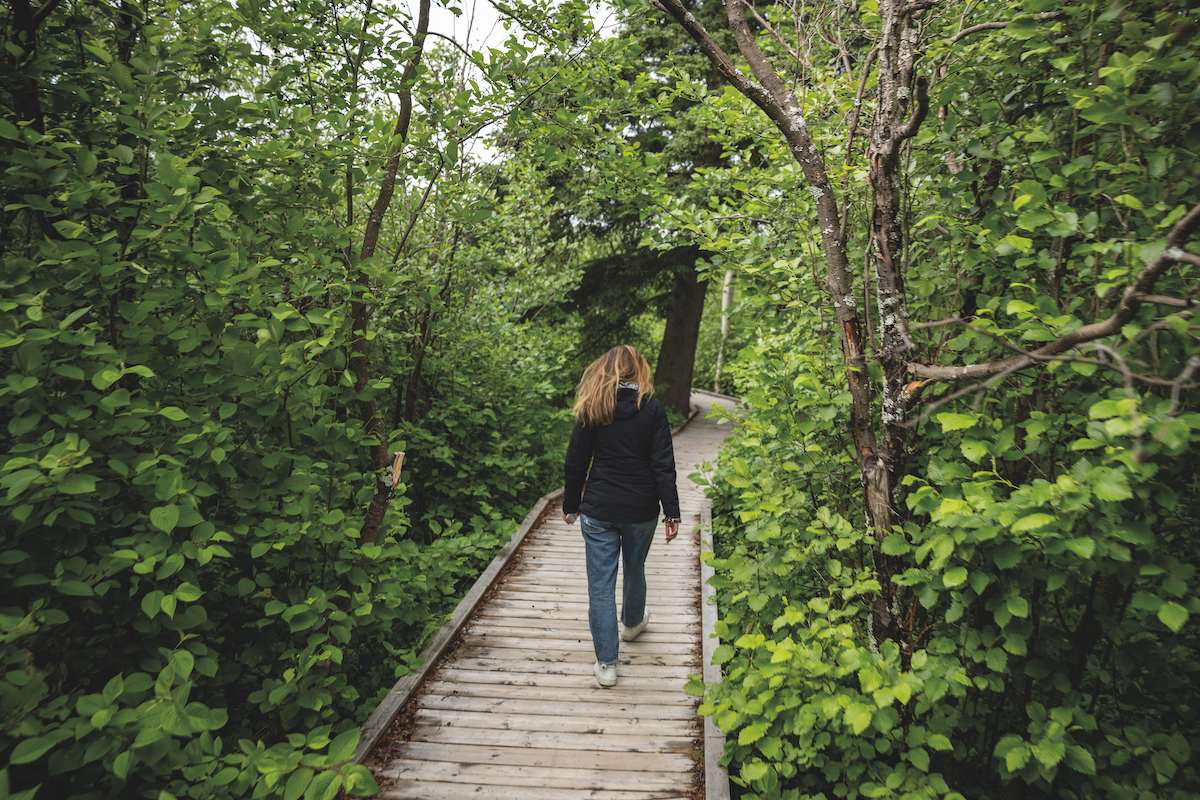
After a tour of the museum (again with Nelson and his dry humor), Janel and I headed back to have a quick rest before dinner and socializing with other guests and residents. On our way, we saw a small grey arctic fox scurrying around the houses. I pulled my camera up and started snapping photographs, thinking I would only have seconds to capture some images of this little critter. Instead, I followed him for about 20 minutes while he stopped to pose, stare at me, stretch and just take it easy. Later, when Nelson took me on a boat ride to find some icebergs and whales, I asked him about the foxes, and he informed me that the animals are very familiar with the residents and often try to get into the homes to rest near the fires. The little rascal was probably hoping I was going to feed him.
After three days of learning about the history and hiking around Battler Harbour and Great Caribou Island, we packed up our bags and started our journey back to the mainland and the motorcycles. On our last day, the sun came out and we sailed away from the sunrise towards the last 1100 km (680 miles) of our trip out east. Janel continually speaks about how much she loved Battle Harbour and wants to go back. It was so interesting to really get to know the people, culture and landscape there. A place as special as Battle Harbour isn’t often found while travelling and it is definitely worth the stop. Overall, it was a fantastic break from the bikes, but now, it was time to carry on.
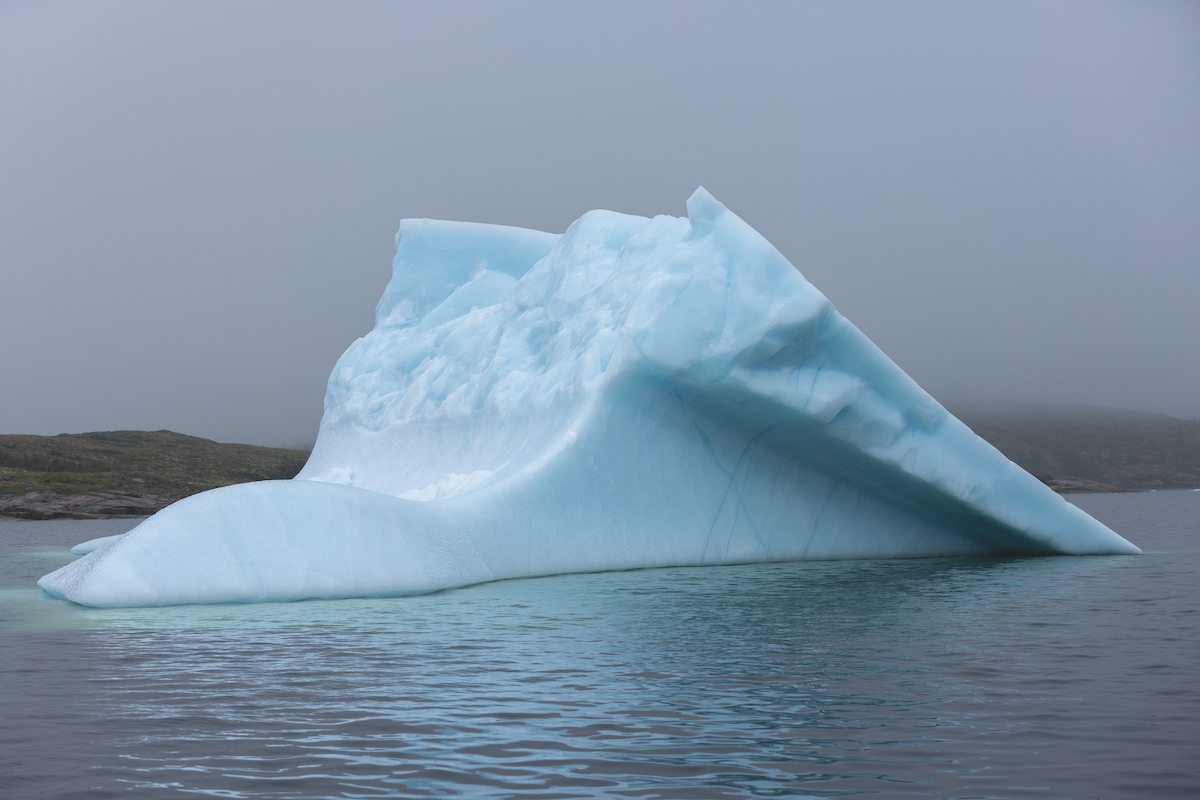
Things to do and places to stay along this section of the Labrador Highway
Battle Harbour
I can’t sell this place much more than I already have. It really is a cultural experience that should not be missed by anyone visiting Labrador. Since our visit, Battle Harbour has started a Trans Labrador Highway Motorcycle Special. The special includes people keeping an eye on your bikes, a place to store your gear in the back room (just ask when you check in), the ferry voyage, guided tours, six meals and one night accommodation; however, you can always extend this (I do recommend staying a minimum of two nights). The cost is about CA$825 (US$625) for two people.
Great Caribou Studio and Café
While you are waiting for you ferry to Battle Harbour, be sure to check out Great Caribou Studio and Café. For a quick coffee or to check out the many crafts. Janel bought a lovely home sweater there that she wears all the time. Contact number (709) 921-6311.
Royal Inn and Suites
Located in Happy Valley-Goose Bay, this hotel is newly renovated and has great staff and fantastic rooms. You will get a good night’s sleep here, which you will need for the long empty highway stretch that awaits you the next day (or after that stretch if you are coming east to west). Prices range from CA$170-285 (US$130-216) for the suite.
Campbell’s Place Inn
There are only two places to stay in Port Hope Simpson, and in my opinion, this is the better of the two. With only a few rooms, a common room, restaurant connected and free laundry, you just can’t go wrong here. Rooms are CA$115 (US$88) per night for two people and include breakfast. You really can’t beat that. To book, give them a call at (709) 960-0291.

